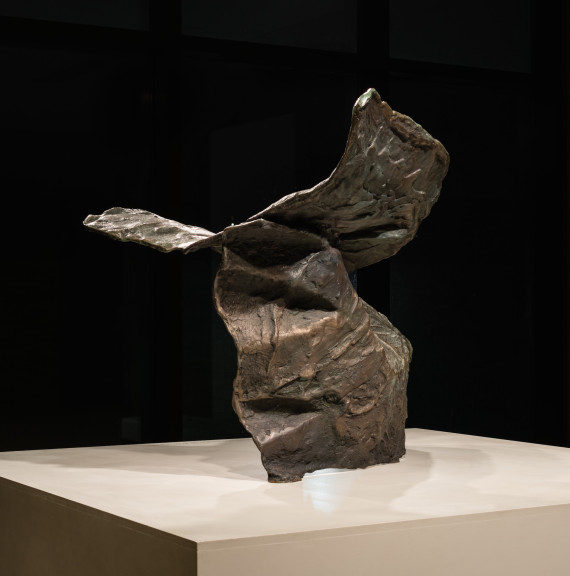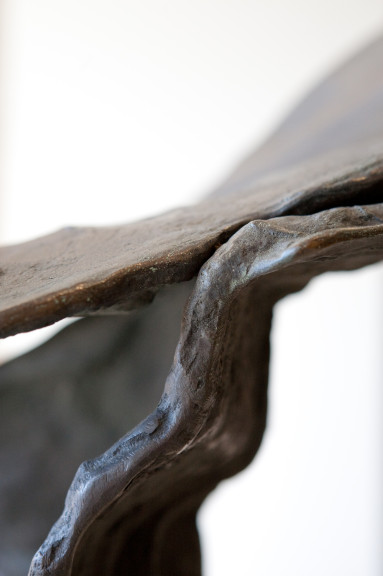Winged Victory
Frederick Kiesler
30 × 28 × 24 1/2 inches
Photography not permitted
Lent by The Metropolitan Museum of Art
Gift of Salander-O’Reilly Galleries, Inc., 1983
1983.200
GPS: 30.285849,-97.731568
A polymath who made important innovations in the fields of architecture, design, painting, and sculpture, Austrian-born Frederick Kiesler moved to New York in 1926 and quickly found his way into the avant-garde circles of American artists and European expatriates. He originally worked in the International Style, a movement that proposed universal solutions to issues of domestic architecture and commercial design. The straight lines, flat planes, and right angles characteristic of the style embodied the utopian vision that simple geometric forms could foster a more rational and egalitarian society.
Like many European artists, Kiesler’s manner of working turned inward during the 1930s, toward the Surrealist project of exploring the subconscious with imaginative and counterintuitive images. Winged Victory alludes to the famous ancient Greek statue Winged Victory of Samothrace in the Louvre. Created to commemorate a military conquest, the female figure in white marble strides forward with widespread wings. In contrast to the classical beauty of the ancient sculpture, Kiesler’s version is fragmentary and abstract: the figure itself has vanished, leaving only its darkened wings collapsing to the ground.
The motif of wings falling to earth evokes other references, such as the Greek myth of Icarus, which resonated with many artists and writers in the years following World War II. With manmade wings of feathers and wax, Icarus became the first human to fly. When he flew too close to the sun, the wax melted, and he plummeted to his death. Similarly, Winged Victory offers a poignant visual metaphor for the collapse of the utopian ideals of Kiesler’s generation, as well as the destruction often inherent in victory.
ACTIVITY GUIDES

Winged Victory
Frederick Kiesler
Subject: Iconic forms
Activity: Using an iconic form to create both a geometric and an organic drawing
Materials: Two pieces of paper and a pencil
Vocabulary: commemorate, geometric forms, iconic, microscopic organisms, organic forms, surrealist
Frederick J. Kiesler was trained as an architect before turning to sculpture and design. He first gained recognition in 1925 at the International Exposition of Decorative Arts in Paris, where he exhibited a large gridlike structure titled City in Space. Later, he became a surrealist and abandoned geometric forms for more organic ones inspired by sources in nature, such as animals, clouds, microscopic organisms, plants, rocks, and water.
This sculpture’s title alludes to the famous Greek statue The Winged Victory of Samothrace from the second century BCE. Created to commemorate a military success, the female figure strides forward with widespread wings. Kiesler reinterpreted that iconic sculpture: here there is no figure, only its blackened wings collapsing to the ground. To viewers familiar with the Greek statue, Kiesler’s sculpture suggests that destruction often comes with victory.
Kiesler fled Europe to escape World War II. What does this tell you about the possible meanings of the sculpture? What kind of comment might he be making about war?
Is this sculpture more geometric or organic? What makes it so?
If you didn’t know about the famous statue The Winged Victory of Samothrace, would Kessler’s sculpture still hold interest for you? How would your interpretation of its meaning change?
Choose an iconic image from our culture; for instance, the Statue of Liberty or Mt. Rushmore. Make two drawings of this image: one using geometric forms and one using organic ones. (You may change the original image by using only a piece of it, as Kiesler does in his sculpture). Think about the differences between the geometric drawings and the organic ones. How does form affect meaning?
In 1959 Kiesler designed the Endless House, in which egglike rooms could enclose inhabitants like a womb. Kessler designed the rooms to be comforting spaces, which would enhance peaceful living.
Many modernist sculptures took on classical Greek ideas or images. For instance, Winged Victory, Hunt’s Amphora, Der Harootian’s Prometheus and Vulture, and Hare’s Swan’s Dream of Leda. Why do you think this is so? What might they have in common? What might be different?
Commemorate - to mark an event, person, or place by some ceremony or observation
Geometric forms - based on simple geometric shapes, such as circles, straight lines, or squares
Iconic - something that is an emblem or symbol
Microscopic organisms - a life form invisible without the use of a microscope
Organic forms - forms related to living organisms
Surrealist - an art style of the early twentieth century that emphasized imagery and visions from dreams and fantasies, as well as an intuitive, spontaneous method of creation that often combined unrelated or unexpected objects in compositions

Winged Victory
Frederick Kiesler
Subject: Symbolism
Activity: Experiment with symbols
Materials: Modeling clay
Vocabulary: Organic, mood, symbolism
Frederick Kiesler is a sculptor from Austria. He uses organic forms to represent larger ideas about humanity and life. Because wings are used for flying, they are often a symbol of freedom. The title of this work, Winged Victory, contradicts what we see. Instead of looking like freedom or the power that comes with victory, we see crumpled metal. If these are wings, as the title suggests, they are wings that might not fly very well.
Do these wings look victorious? What kind of victory could they represent?
If they do not represent victory, what might they represent?
What is the mood of this sculpture? Happy? Sad? Proud?
Think of an item that is used as a symbol for a larger idea. For example, wings may be symbolic of freedom; the color blue we often take to mean sadness; the heart is a symbol for love; and the moon is a symbol for the night. Using modeling clay, make several versions of the same symbol. Experiment by making them larger or smaller, whole or broken, or in different colors. How does the meaning of the symbol change when you alter how the symbol looks?
Organic —Looking like shapes found in nature
Mood —Mental or emotional state or disposition
Symbolism —Representing an idea or concept through images

Winged Victory
Frederick Kiesler
Subject: Texture
Activity: Textured rubbings
Materials: Paper, crayons or colored pencils, and scissors
Vocabulary: Texture, sculpture, shape
Texture is how something feels to the touch, or looks like it would feel. There are many types of textures, including rough, smooth, or soft, and things can have many textures at once.
This sculpture is called Winged Victory. When we think of wings, we think of the very soft texture of feathers. This artist chose to make wings out of rough, hard and heavy metal, instead of soft and light feathers.
Do you think these wings could fly?
Why do you think the artist chose to make these wings so different from a real bird’s wings?
If the sculpture had the texture of real wings, how would it be different?
In your house and yard help your child find objects that have texture, such as the bark of a tree, concrete, or the tiles in your kitchen. Lay a piece of paper over them and rub the paper with a crayon or pencil. Point out the pattern or texture that is now on the paper. Once you have several different examples of texture, encourage your child to think of a shape. It can be a simple geometric shape, like a circle or star, or the shape of a familiar object, like a tree or house. Help your child cut this same shape out of the different textures. Ask how does the texture change what the shape means?
Texture —How the surface of something looks or feels (for example, rough or smooth)
Sculpture —A work of art that has height, width, and depth
Shape —An outline of a body, like a circle or square
MORE INFORMATION
Frederick Kiesler trained as an architect before turning to sculpture and design. Like many other European modernists in the 1920s, he was a utopian idealist. Kiesler first gained recognition in 1925 at the International Exposition of Decorative Arts in Paris, where he exhibited a large gridlike structure titled City in Space. Its straight lines and flat planes joined at right angles embodied the utopian belief that simple geometric forms in art would help facilitate a more rational and egalitarian society.
Within a few years, however, Kiesler abandoned that approach in favor of curving biomorphic forms. The new surrealist movement rejected rationality and regularity in art. Arguing that human beings are organic, the surrealists favored forms inspired by sources in nature—plants, animals, microscopic organisms, water, clouds, and rocks, for example. Kiesler began to conceive buildings based on open, ovoid forms, which he called “endless” because they could be infinitely adaptable. His drawings and models were hopeful conceptual prototypes rather than pragmatic plans.
Kiesler fled Europe during World War II and settled in New York, where he earned income primarily by designing store windows, exhibition spaces, and theater sets. In 1959 he designed the Endless House, in which egglike rooms could enclose the inhabitants like a womb and thereby “foster peace within.”
Winged Victory, c. 1951
This sculpture’s title alludes to the famous Greek statue The Winged Victory of Samothrace from the second century BCE. Created to commemorate a military conquest, the white marble female figure strides forward with widespread wings. Her body, wings, and clothing are wonderfully animated as if in an invigorating breeze. Since the early nineteenth century, the statue has stood prominently on the main landing of the grand staircase of the Louvre Museum in Paris, where it has been seen by millions of visitors.
Kiesler reinterpreted that iconic monument to victory: here the figure has vanished, leaving only its blackened wings falling to the ground. To viewers familiar with the Greek statue, Kiesler’s sculpture offers a poignant visual metaphor for the collapse of the ideas and ideals of Western civilization and the destruction often inherent in victory.
The motif of wings falling to earth evokes other sources as well, such as the biblical downfall of angels immortalized in John Milton’s epic poem Paradise Lost. In the years after World War II, the ancient Greek tale of Icarus appealed to some artists and writers. On manmade wings of feathers and wax, Icarus became the first mythic human to fly. But he flew too close to the sun (symbol of divinity to the Greeks), the wax melted, and Icarus crashed to his death on earth—much as the utopian aspirations of Kiesler’s generation had been crushed by war.
Valerie Fletcher is Senior Curator at the Hirshhorn Museum in Washington, DC. Her research on groundbreaking aspects of international, globalized, and transnational art have resulted in numerous exhibitions and publications.
Barr, Alfred H. “Kiesler’s Galaxy.” Harper’s Bazaar, April 1952, 142–43.
Bogner, Dieter, and Peter Noever, eds. Frederick Kiesler: Endless Space. Ostfildern-Ruit, Germany: Hatje Cantz, 2001. Texts by Dieter Bogner, Greg Lynn, Lisa Phillips, and Lebbeus Woods.
Davidson, Susan, and Philip Rylands, eds. Peggy Guggenheim and Frederick Kiesler: The Story of Art of This Century. New York: Solomon R. Guggenheim Museum, 2005. Texts by Dieter Bogner, Susan Davidson, Francis V. O’Connor, Don Quaintance, Philip Rylands, Jasper Sharp, and Valentina Sonzogni.
De Kooning, Elaine. “Dickinson and Kiesler.” Art News 51 (April 1952): 20–23, 66–67.
Goldberg, RoseLee. “Frederick Kiesler, Endless Love.” Flash Art 102 (March/April 1981): 37–39.
Kiesler, Frederick. Inside the Endless House; Art, People, Architecture: A Journal. New York: Simon and Schuster, 1966.
Kiesler, Frederick, and Thomas Creighton. “Kiesler’s Pursuit of an Idea.” Progressive Architecture 42 (July 1961): 112.
Kiesler, Frederick, Harald Krejci, and Valentina Sonzogni. Frederick Kiesler: Endless House, 1947–1961. Ostfildern-Ruit, Germany: Hatje Cantz, 2003.
Levin, Kim. “Kiesler and Mondrian: Art into Life.” Art News 63 (May 1964): 38–41, 49–50.
McGuire, Laura M. “A Movie House in Space and Time: Frederick Kiesler’s Film Arts Guild Cinema, New York, 1929.” Studies in the Decorative Arts (Spring/Summer 2007): 45–78.
Phillips, Lisa, ed. Frederick Kiesler. New York: Whitney Museum of American Art, 1989. Texts by Dieter Bogner, Cynthia Goodman, Barbara Lesák, Jeanne T. Newlin, and Lisa Phillips.
Safran, Yehuda, ed. Frederick Kiesler, 1890–1965. London: Architectural Association, 1989. Texts by Dieter Bogner, Jennifer Gough-Cooper and Jacques Caumont, Frederick Kiesler, Barbara Lesák, and Yehuda Safran.
Solomon R. Guggenheim Museum. Frederick Kiesler: Environmental Sculpture. New York, 1964.
The Metropolitan Museum of Art in New York generously loaned twenty-eight modern and contemporary sculptures to Landmarks for display throughout the Austin campus. The collection represents a broad array of artists working in the second half of the twentieth century. The initial sculptures were installed throughout the main campus in September 2008, and a second, smaller group were unveiled at the renovated Bass Concert Hall in January 2009.
Funding for the loan was provided by the Office of the President. This project was the result of a collaborative effort among many, including:
Leadership
Andrée Bober and Landmarks
Pat Clubb and University Operations
Douglas Dempster and the College of Fine Arts
Landmarks Advisory Committee
William Powers and the Office of the President
David Rea and the Office of Campus Planning
Bill Throop and Project Management and Construction Services
Gary Tinterow and the Metropolitan Museum of Art
Samuel Wilson and the Faculty Building Advisory Committee
Project Team
Chuck Agro, transportation, Metropolitan Museum of Art
Andrée Bober, curator and director, Landmarks
Caitlin Corrigan, registrar, Metropolitan Museum of Art
Cynthia Iavarone, collections manager, Metropolitan Museum of Art
Cliff Koeninger, architect
Ricardo Puemape, Project Management and Construction Services
Kendra Roth, conservator, Metropolitan Museum of Art
Patrick Sheehy, installation services
Nicole Vlado, project manager, Landmarks
Special Thanks
Valerie Fletcher, curatorial contributor
Beth Palazzolo, administrative coordination, University Operations
Russell Pinkston, composer
What’s Past Is Prologue: Inaugurating Landmarks with the Metropolitan Sculptures
With the arrival of twenty-eight modern sculptures on long-term loan from New York’s Metropolitan Museum of Art, the Landmarks program has begun. Their installation throughout the Austin campus offers a remarkable opportunity to survey some of the major trends in art during the second half of the twentieth century. These sculptures allow us to witness the distinctly modern dialogue between representation and abstraction, as well as the contest between natural and industrial materials. Most of all, we can celebrate their presence as an unprecedented chance to experience works of art first-hand––to appreciate their forms and to understand the underlying ideas.
The Landmarks program perpetuates in Austin one of civilization’s oldest and most enduring traditions: the placing of art in public areas, accessible to nearly everyone and expressive of collectively held ideas. More than five thousand years ago, the cultures of Egypt and Mesopotamia produced sculptures for urban plazas, government buildings, and places of worship to express political, secular, and religious values. Grand monuments endorsed the ruling elite and commemorated military victories, while images of deities symbolized spiritual beliefs. The original purposes of public art were primarily ideological and didactic, but what has endured through the ages is the physical beauty of the art. In modern times the contexts and goals for public art have changed considerably. In many parts of the world democracy and egalitarianism have supplanted absolute rulers, and explicit religious power has yielded to secular humanism. During the mid-to-late twentieth century (the era when the Metropolitan’s sculptures were created), globalization has redefined the entire world. Societies in Europe and the Americas have became so diverse that cultural authorities can no longer be sure of which systems of meaning and which values, let alone which individuals, should be honored in the traditional ways of public art.
A schism has developed between traditionalists and modernists. In a rapidly changing world those who wanted to preserve the familiar in art have continued to commission representational statues. Modernists, on the other hand, have embraced change and gladly jettisoned the old ways in favor of abstraction. The schism is exemplified by two famous memorials in Washington, D.C., both intended to commemorate the heroic sacrifices of American armed forces. The Marine Corps Memorial (1954) consists of a superbly realistic representation of soldiers struggling to raise the American flag on Iwo Jima in 1945. In contrast, the Vietnam Memorial (1982) consists of a massive V-shaped wedge of polished black stone inscribed with What’s Past Is Prologue: Inaugurating Landmarks with the Metropolitan Sculptures July 2008 the names of the dead. At the time it was inaugurated, this monument shocked nearly everyone outside the art world and outraged many of those it intended to commemorate. In response, a group of bronze figures of soldiers was added. But soon, precisely because of its universal form and absence of imagery, the original memorial became a powerful place where all Americans could go to grieve, remember, and pay homage. To most of the art world, this demonstrated beyond a doubt the viability of abstract sculpture for public places.
With America’s increasing wealth and social consciousness in the 1960s many towns began to institute programs of commissioning sculptures for public places. By requiring that 1 or 2 percent of each building’s construction budget be used for art, urban planners sought to improve the living and working environment for millions of people. The main difficulty was agreeing on what kind of art was visually pleasing and, just as important, potentially meaningful to the general public. Two highly publicized examples were the huge, abstract, metal sculptures by Pablo Picasso and Alexander Calder, in Chicago and Grand Rapids respectively, which at first provoked derision but gradually became a source of community identity and pride.
One way to approach works of art is to consider the historical context in which they were created. During the first half of the twentieth century, life and art underwent radical transformations. Industrial manufacturing supplanted agriculture as the dominant mode of production, people migrated from rural areas to urban centers, women and minorities gained equal rights, warfare expanded to an unprecedented global scale, and technology accelerated the pace of life—and art changed in tandem.
Abstraction
Early in the modern era, many artists believed that a new visual language was needed to replace the Greco-Roman classical figurative traditions that had persisted through two millennia. Photography had made mimesis (accurate depiction of reality) unnecessary in painting and sculpture for the first time in history. Artists were free to conceive radically new approaches, and so abstraction was born, emerging from 1910 to 1920 in Europe. Initially artists simplified and stylized observed reality into organic and angular forms. That first phase soon evolved into making “pure” abstractions with no recognizable sources. From the outset, abstract art carried implicit meanings recognized by artists and informed viewers but largely lost on the general public.
Early abstractionists intended their art to convey their commitment to an ongoing transformation of society. Like Morse code in telegraphy and other new modes of communication fundamentally different from the traditional written word, abstract forms in art could convey meanings—not narrative or literal ones but broad ideas that could speak to an international audience and help advance human consciousness.
During the 1920s and 1930s, artists developed two broad types of abstraction: geometric and biomorphic. Geometry denotes mathematics and suggests such related disciplines as architecture, design, engineering, and logic as well as intangible qualities like analytical thinking and precision—desirable attributes for a rational, communal society. Artists devised a new language of geometry in art: horizontal and vertical elements can convey calm, harmony, and stability (see Harmonious Triad by Beverly Pepper), while rising diagonals can suggest energy and optimism (see Column of Peace by Antoine Pevsner and Square Tilt by Joel Perlman).
In contrast to geometric abstraction, a number of artists favored softer forms and curving contours. Inspired by sources in nature, biomorphic abstractions evoke natural phenomena, biological processes, growth, and ambiguity (see Big Indian Mountain by Raoul Hague, Source by Hans Hokanson, and Untitled [Seven Mountains] by Ursula von Rydingsvard). Such works stand in general opposition to the industrial and technological aspects of modern life; they remind us of the fundamental importance of the natural world. Biomorphism was invented and advocated by the surrealists, who believed in the importance of the unconscious mind in creating and understanding modern art. Relying on the Freudian concept of free association, such artists expect viewers to generate their own unique responses to abstract art.
The two types of abstraction began as competing and opposing philosophies, but by the 1950s many artists expertly combined them to suit their expressive needs (see the rhythmic contours of Veduggio Glimpse by Anthony Caro and the disconcerting, hulking forms of Catacombs and Guardian by Seymour Lipton).
By the 1960s, the original philosophical meanings underlying abstraction had mostly faded away, leaving “formalist” aesthetics: the creation and appreciation of pure nonreferential beauty. Formalism dominated much artistic practice from the 1950s through the 1970s, particularly in the United States in the circle around the critic Clement Greenberg. Geometric sculptures became ubiquitous in public places—some complex and sophisticated and some merely competent. A group known as the minimalists advocated an intellectually rigorous, austerely reductivist approach (see Amaryllis by Tony Smith). Other artists went in the opposite direction, toward complexity and a decorative verve (see Kingfish by Peter Reginato). From those extremes emerged the postminimalists, who infused organic vitality into simple, singular forms (see Curve and Shadow No. 2 by Juan Hamilton).
Figuration
Despite the enthusiasm for abstraction in midcentury, a number of artists insisted on maintaining recognizable human content in their works. Abstraction had alienated many viewers who found it remote or incomprehensible. Yet few artists returned to traditional realism, preferring instead to explore new and evocative modes of representation.
The strongest resurgence occurred in the aftermath of World War II. Many artists, especially in Europe, wanted to pay homage to the sufferings experienced by so many people during the war and to their struggles to rebuild their lives and societies amidst the new fears engendered by the nuclear age and the Cold War. This atmosphere of postwar existential anxiety was poignantly expressed in two museum exhibitions in the 1950s: models for a never-realized Monument to the Unknown Political Prisoner at London’s Tate Gallery in 1953 and the avowedly humanist theme of the New Images of Man installation at New York’s Museum of Modern Art in 1959.
Many postwar sculptors expressed their angst by portraying figures or fragments of bodies as falling, broken, injured, or partially robotic (see Augustus by Bernard Meadows and Figure by Eduardo Paolozzi). Some erudite artists reinterpreted classical myths, particularly those in which a hero challenged the gods and were punished: Icarus, Hephaestus, Prometheus, Sisyphus (see works by Koren der Harootian and Frederick Kiesler). Seymour Lipton created a particularly effective amalgam of figure references within abstract forms that harbor dark inner spaces (see Pioneer, Catacombs, and Guardian).
Representational sculpture was submerged by the tidal wave of abstraction in the 1960s and 1970s, but a new generation insisted on a legible humanist content in art, addressing issues of personal identity and isolation in an impersonal world (see Eyes by Louise Bourgeois and Figure on a Trunk by Magdalena Abakanowicz).
Materials and Methods
Modern sculptors also introduced a new language of materials and methods. In the late nineteenth century, sculpture making had entered a new phase of mass production made possible through technology: bronzes could be produced in large editions by skilled technicians from an artist’s original. The Thinker by Auguste Rodin, for example, was made in several editions, ranging from a dozen life-size bronzes to hundreds of smaller casts. This mechanization and concomitant commodification of art prompted a reaction. Appearing simultaneously in several countries, the “direct carve” movement advocated older craft-based methods and sought to enhance the intrinsic characteristics of natural materials: the color and grain of exotic woods or the veining and crystalline structure of unusual stones. By the 1920s, this aesthetic had gained international prominence, and it persists to this day.
The first generation of direct carvers admired prehistoric, African, Oceanic, and indigenous American artifacts. By adapting the hieratic frontality and stylized forms of those sources to the sleekly refined forms of abstraction, modern sculptors could represent simplified figures linked in sophisticated linear rhythms (see works by Koren der Harootian and Anita Weschler). Recent artists of this orientation tend to work on a larger scale and may roughly cut and hew wood to achieve expressionistic textures (see works by Hans Hokanson and Ursula von Rydingsvard).
Carvers remained a relatively small minority in modern sculpture, far outnumbered by “direct metal” sculptors. Their approach emerged in prewar Europe and burgeoned into an international movement in the 1950s and 1960s. Seeking materials and methods appropriate to the modern Machine Age, artists looked to engineering and construction for inspiration. Instead of using chisels to carve wood and stone, constructivists preferred welding torches to cut and join pieces of metal. Their structures ranged from elegant abstractions to assemblages of cast-off objects.
The industrial analogy and model extended to the sculptors’ own studios, which resembled factory spaces with heavy-duty equipment. Some—like Anthony Caro, Willard Boepple, and Robert Murray—found inspiration in working spontaneously and experimentally with sheet metal: cutting, folding, rolling, welding, soldering, and sometimes painting or burnishing it. Other sculptors, notably Tony Smith, were comfortable with sending models to factories for professional fabrication. Both methods were considered appropriate for a modern world that had been so fundamentally reshaped by industrial manufacture.
In contrast, many sculptors preferred to make assemblages from miscellaneous bits and pieces of scrap, sometimes irreverently called “junk sculpture.” Although artists had experimented with this approach as early as the 1910s, it became a widespread tendency only decades later in the 1950s and 1960s, when sculptors made three-dimensional collages from the detritus of industrial manufacture and mass consumption: rusty machinery, old car parts, squished used paint tubes, broken musical instruments, virtually anything. The motivations for using trash range from simple necessity (when an artist has no money to buy new materials) to antimaterialistic social criticism and environmentalism (sculptors started recycling long before the idea occurred to others).
Regardless of the motivations, a found-object sculpture possesses an inherent dual identity: its former reality as a useful thing and its new reality as art. That dualism inevitably poses an intellectual and visual conundrum for us. Do we see Deborah Butterfield’s Vermillion primarily as a lifelike depiction of a horse or as a composition of rusty, crumpled bits of metal thrown out by a wasteful consumerist society? And what are we to understand from Donald Lipski’s seemingly abstract The West, which consists of decontextualized harbor buoys and lots of corroded pennies? The artists offer clues and hope that we will use our own eyes, intellect, intuition, and imagination to make connections and create meanings.
Landmarks: Sculptures for Inquiring Minds
Unlike works in private collections or even museums, public sculptures exist in our daily environment, interact with our activities, and enter our awareness repeatedly and variously. Beyond the pleasure they bring to viewers already acquainted with art, they can stimulate curiosity and spark new perceptions in the minds of passersby who might otherwise not have much aesthetic experience. As the university’s population seeks knowledge in classes, libraries, and laboratories, the Landmark sculptures can offer other kinds of discoveries. Visitors to the Perry Castañeda-Library, the Nano Science Technology Building, the School of Law, and elsewhere on the campus can now see immediately that the visual arts have a prominent place and come away enriched. Very few campuses or cities can boast so many sculptures of such quality that are free and accessible to all. The twenty-eight sculptures from the Metropolitan Museum of Art proclaim the broad purpose of the Landmarks program: to bring an important new dimension to the life of the university, to the everyday experience of its students, faculty and staff, the citizens of Austin and beyond, and to any person who just crosses the campus.
Valerie Fletcher is Senior Curator at the Hirshhorn Museum in Washington, D.C. Her research on groundbreaking aspects of international, globalized, and transnational art have resulted in numerous exhibitions and publications.


